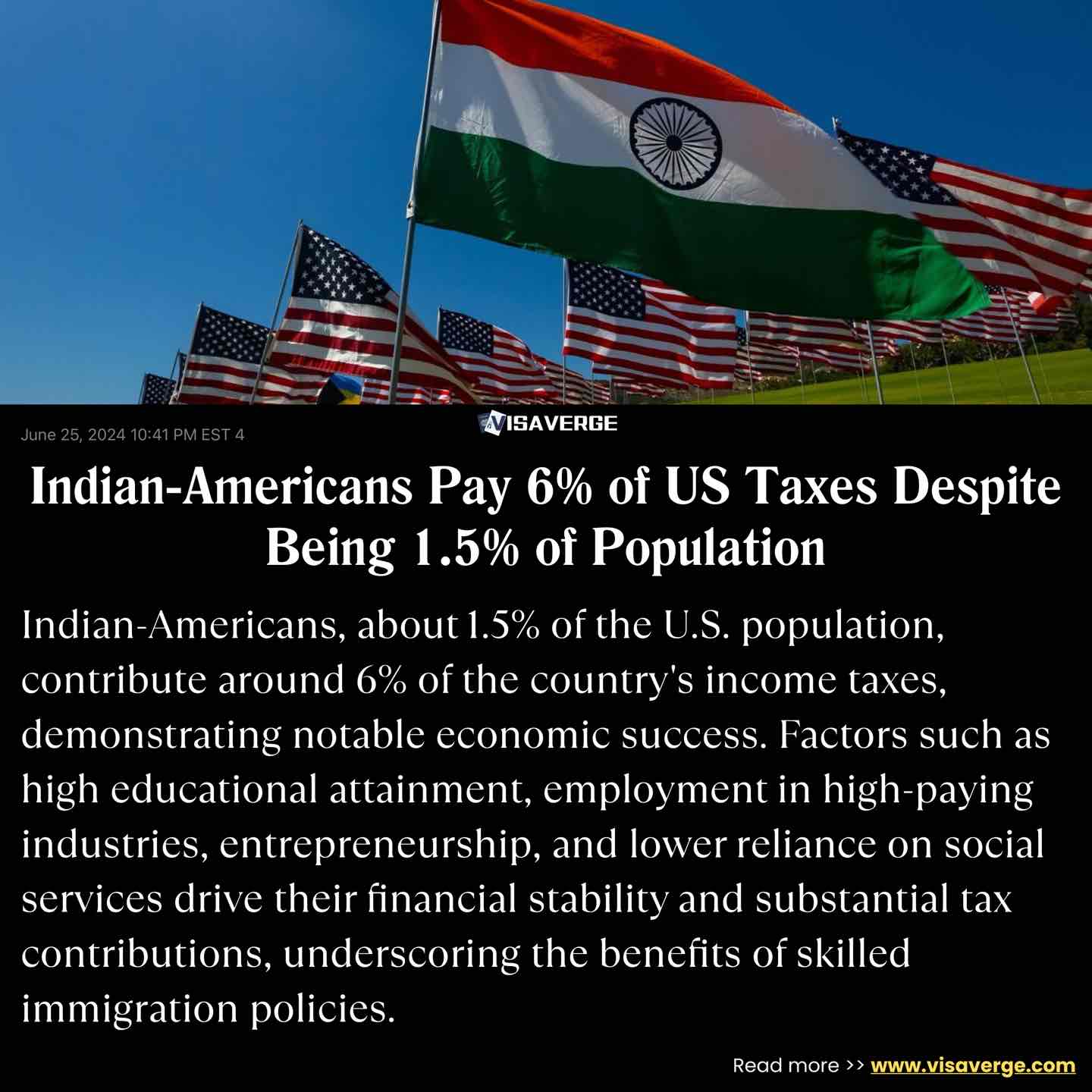Key Takeaways:
- Indian-Americans, 1.5% of the U.S. population, contribute about 6% of all income taxes due to economic success.
- Key factors: high educational attainment, concentration in high-paying industries, entrepreneurship, and geographic distribution in high-tax states.
- Cultural values, low social service reliance, legal immigration, and generational wealth bolster their financial stability and substantial tax contributions.
What Proportion of US Taxes Do Indian-Americans Contribute?
According to recent reports, Indian-Americans, constituting around 1.5% of the U.S. population, contribute about 6% of all income taxes paid in the country. This highlights the remarkable economic success and high-earning potential of the Indian-American community.

Why Do Indian-Americans Have High Economic Success?
Several factors contribute to the economic success of Indian-Americans:
High Educational Attainment
Indian-Americans emphasize education, with many holding advanced degrees. These qualifications lead to higher-paying jobs and increased income levels. Educational excellence is a key driver in their economic success.
Concentration in High-Paying Industries
Many Indian-Americans work in lucrative industries like technology, medicine, finance, and engineering. These fields typically offer above-average salaries, leading to larger tax contributions.
Entrepreneurship and Business Leadership
The Indian-American community has a strong entrepreneurial spirit, with many individuals starting successful businesses. This results in higher incomes and, consequently, higher tax payments. Notable leaders of Indian origin, such as Microsoft’s Satya Nadella and Google’s Sundar Pichai, head 16 Fortune 500 companies that collectively employ 2.7 million Americans and generate nearly $1 trillion in revenue.
How Does Geographic Distribution Affect Tax Contributions?
Indian-Americans tend to live in urban areas and states with higher costs of living and higher tax rates, such as California, New York, and New Jersey. This further increases their overall tax contributions. In these regions, higher incomes often correlate with higher tax payments.
Does Family Structure Influence Economic Success?
Indian-American households often feature multiple working adults, leading to higher household incomes. This contributes to increased tax payments.
Employment Rates Among Indian-Americans
The Indian-American community generally experiences lower unemployment rates compared to the national average. This means a higher percentage of the population is actively contributing to the tax base.
What Cultural Values Drive Financial Stability?
Financial success and stability are highly valued in the Indian-American community, translating to higher incomes and, consequently, higher tax contributions. Their low reliance on social services means a higher percentage of their income goes towards taxes rather than being offset by government assistance.
The Impact of Legal Immigration Status
Most Indian-Americans have entered the country through legal channels, often on skilled worker visas like the H-1B. These individuals are often in high-paying jobs from the outset of their time in the U.S., contributing significantly to the tax base.
Generational Wealth and Economic Success
As the Indian-American community becomes more established in the U.S., subsequent generations benefit from the economic success of their parents. This potential for even higher incomes ensures continued substantial tax contributions.
Lower Reliance on Social Services
Indian-Americans generally have lower rates of poverty and reliance on social services. This means a higher percentage of their income is directed towards taxes.
Contributions to US Prosperity
Indian-Americans own a significant number of U.S. hotels and have co-founded 72 of the 648 U.S. unicorn startups, employing over 55,000 people and valued at $195 billion. In academia, they hold numerous patents and receive key research grants. Educationally, Indian-Americans excel, with 78% holding a bachelor’s degree or higher, compared to the U.S. national average of 36%.
How Does the Indian-American Community Enhance American Cultural Life?
Culturally, the Indian-American community enriches American life with its cuisine, festivals, and literature. This cultural integration benefits both the U.S. and India. Politically, Indian-Americans hold significant positions, including Vice President Kamala Harris.
What Are the Philanthropic Contributions of Indian-Americans?
The achievements of the Indian diaspora also benefit India, with over $1.5 billion donated to U.S. philanthropic causes and around $830 million sent to India in 2018-19, making up 35% of all donations sent to the country.
Are There Challenges Faced by the Indian-American Community?
Despite numerous success stories, the Indian community does face challenges. As of 2020, around 6% of Indian-Americans live below the poverty line, and an estimated 14% were undocumented in 2021.
What Does This Tax Contribution Say About Broader Issues?
The significant tax contribution of Indian-Americans indicates their economic success but also reflects broader issues of income inequality. It calls for a more equitable distribution of the tax burden across all segments of society.
Conclusion
The fact that 1.5% of the population contributes 6% of all U.S. taxes demonstrates the outsized economic impact of the Indian-American community. Their role as significant contributors to the United States’ economy and tax base is noteworthy. Leaders and policymakers often highlight the positive impact of Indian-Americans on the country. According to VisaVerge.com, this underscores the importance of immigration policies that attract skilled workers and entrepreneurs, enhancing the country’s economic growth and financial health. For more information on immigration policies, you can visit the official U.S. Citizenship and Immigration Services website.
Learn Today:
Glossary of Immigration Terms
- H-1B Visa: A non-immigrant visa that allows U.S. companies to employ foreign workers in specialty occupations that require theoretical or technical expertise, such as IT, engineering, and medicine. Many Indian-Americans enter the U.S. through this visa.
- Skilled Worker Visa: A category of visa that permits foreign workers with specialized skills, education, or experience to work in the U.S. This often includes professions in fields like technology, finance, and medicine, contributing to higher incomes and tax contributions.
- Income Taxes: Financial charges imposed by the government on individuals and businesses based on their income levels. The contribution of 6% of U.S. income taxes by Indian-Americans indicates their significant economic impact.
- Generational Wealth: The transmission of financial resources, properties, and other assets from one generation to another. This enables subsequent generations to benefit from the economic success of their parents, ensuring sustained financial stability and tax contributions.
- Entrepreneurial Spirit: The mindset and determination to create and manage businesses, contributing to economic growth. This trait is strong among Indian-Americans, leading to higher incomes and significant tax contributions through successful business establishments.
This Article In A Nutshell:
Indian-Americans, 1.5% of the U.S. population, contribute around 6% of its income taxes. High educational attainment, employment in high-paying industries, business leadership, and geographic distribution in urban areas explain their substantial economic impact. Their contributions significantly bolster the U.S. economy.
— By VisaVerge.com
Disclaimer: The information provided in this article is for informational purposes only. If you reference or use any content from this article, please attribute it to VisaVerge.com by including a link to the original source. We appreciate your adherence to our content usage policies and your commitment to giving proper credit.
Read More
- U.S. Diplomat Highlights Need for Chinese Students in Humanities and Indians in Science
- New H-1B Visa Rules from July 8th: Impact on Indian Nationals
- 40-Day Jail Sentence for Abusing Indian Nationals in the U.S.
- Schengen Visa Applications Surge by 43% Among Indians in 2023
- No Violence Reported Against Indians in Kyrgyz Republic: Official Report













